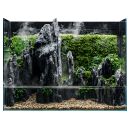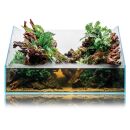UNS Paludarium - Land meets water
Ultum Nature Systems Paludaria: The Combination of Aquarium and Terrarium
A paludarium is a fascinating ecosystem that combines both aquatic and terrestrial habitats. It offers a unique opportunity to house a variety of living organisms in a controlled environment. Maintaining a paludarium requires special knowledge and skills, as it needs to cater to the requirements of both habitats. Setting up a paludarium starts with choosing the right container, capable of housing both a water section and a land section.
UNS Paludaria are available in various sizes and designs. Our online shop offers volumes ranging from 8 to 25 litres for the aquarium portion. The particularly popular 60E model provides an ideal compromise between ample size for creative freedom and manageable maintenance. The paludaria are made of high-quality diamond glass and feature a range of innovative characteristics that make them an ideal choice for paludarium enthusiasts.
Key features of the UNS Paludaria include:
Rimless Design: The paludaria have an elegant, minimalist design with no visible frame.
45-Degree Glass Edges: The glass edges are mitred, enhancing the paludarium's stability and offering great views of the layout.
Ultra-Clear Glass: The glass is exceptionally clear and reflections are minimal, making the colours of the plants and hardscape stand out more vividly.
Foresta Integrated Paludarium:
The Foresta Paludarium System is a fully integrated system, equipped with a filter for the aquatic section and a cascade waterfall wall. Additionally, the system includes an ultrasonic nebuliser, creating an impressive mist effect and increasing humidity.
The integrated filtration makes additional external devices redundant. The three-chamber filter system contains the USB-powered water pump, coarse aquarium sponges, and the nebuliser. All three chambers work together to provide filtration, misting, and a waterfall effect, leading to smooth operation and a beautiful tropical environment.
Selecting suitable plants that thrive in this specific habitat is also an important consideration. With proper care and maintenance, a paludarium can be a stunning and vibrant depiction of nature.
Advantages of a paludarium
A paludarium offers numerous benefits. It creates a natural habitat for a wide variety of living organisms. By combining an aquatic and terrestrial area, different habitats can be simulated. Additionally, a paludarium allows for the cultivation of plants that thrive both underwater and on land. It is also aesthetically appealing and can be an eye-catcher in any home. Furthermore, a paludarium promotes the formation of a healthy ecosystem, contributing to pest reduction. It also provides an excellent opportunity to observe and explore various aspects of animal and plant life.
Aesthetic Design Possibilities
Aesthetic design is an art that aims to create visually appealing and meaningful designs. There are many techniques to make the layout aesthetically appealing. Colours, shapes, lines, textures, and spaces play a vital role. Colours can evoke moods, feelings, and responses. Shapes can help convey a particular message. Lines can represent movement and energy. Textures can change the look and feel of a design. Spaces can create depth and perspective. A good aesthetic design takes all these elements into account to create a harmonious and coherent overall image.
Planning and Setting Up a Paludarium
Planning and setting up a paludarium require careful consideration. It starts with selecting the right container, which must be large enough to accommodate a diverse range of flora and fauna. Designing the habitat includes both land and water areas, with the ideal ratio varying depending on the intended inhabitants. Proper lighting is also important to promote plant growth while creating a pleasant atmosphere. The right-sized water filtration is essential to ensure a healthy habitat.
Setting Up the Necessary Technology (Lighting, Ventilation, Filtration, Heating)
When setting up the necessary technology for a paludarium, four key factors must be considered: lighting, filtration, heating, ventilation. Proper lighting is essential to encourage plant growth. Filtration is a critical aspect, as it helps keep the water clean and prevents the accumulation of harmful chemicals and detritus. Finally, suitable heating is necessary to maintain the correct water temperature. A humidifier in combination with a fan can provide optimal humidity and ventilation. Each of these aspects requires careful planning and implementation to ensure that the paludarium remains healthy and attractive.
Care and Maintenance of a Paludarium
Caring for and maintaining a paludarium requires attention and patience. An important aspect is maintaining the correct temperature and humidity. Regular cleaning is also crucial to prevent the formation of algae or mould. It is important to monitor water quality and treat it as necessary to maintain a healthy ecosystem. The health and growth of the plants should also be monitored. In case of diseases or pests, prompt action is required. Good maintenance also includes regular pruning of plants and removing dead material. With the right care and maintenance, the paludarium can remain a thriving and vibrant miniature world.
Inspiration and Tips for Designing a Paludarium
A paludarium is a wonderful piece of nature for the home. Natural materials such as stones, moss, and wood are excellent for creating a realistic landscape. It is important to ensure that a good filtration system is in place to keep the water clean and clear. Good lighting is also important to promote plant growth and create a pleasant atmosphere.
Regular care and maintenance are essential to ensure that the paludarium remains healthy and vibrant. It is advisable to learn about the specific needs of the plants and animals to ensure they thrive.
Thematic Design Possibilities (Rainforest, Mangroves, Desert)
In thematic design, whether it's rainforest, mangroves, or desert, the choice of theme can have a significant impact on the overall effect. When depicting a rainforest, one should focus on the diversity of plants and animals as well as the dense greenery. In mangroves, the unique root systems and the interplay of land and water are central. A desert landscape is characterized by minimal plant growth, extensive sand areas, and extreme temperature fluctuations. In each thematic design, it is important to remain authentic and highlight the characteristic elements of the chosen theme. The climatic and geographical conditions that shape the appearance of the chosen theme should also be considered. Incorporating these aspects into the design can help create a convincing and realistic representation.


